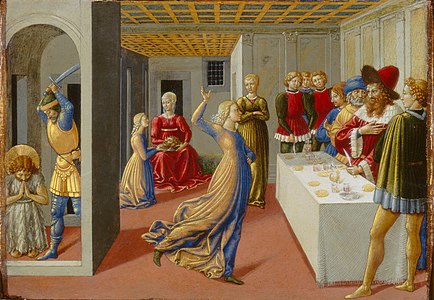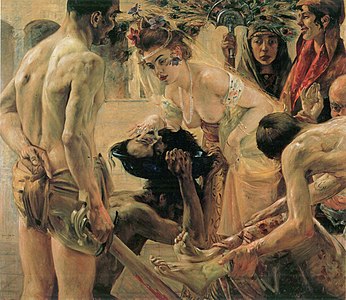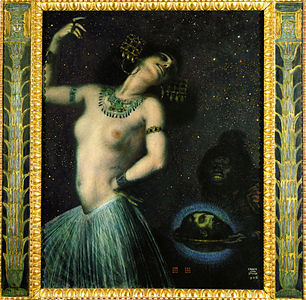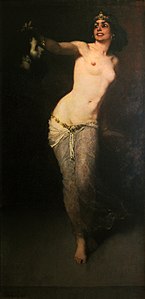Salome (daughter of Herodias)



Salome ([ ˈzaːlomeː ]) was according to Flavius Josephus the name of a daughter of Herodias . In the later tradition this name was brought into connection with the story of the death of John the Baptist told in the Gospels, but which only speaks of the daughter of Herodias. Salome, the daughter of Herodias, was later (from 54 AD) queen in Lesser Armenia .
She is not related to the disciple Salome mentioned in the Gospel of Mark .
family
Salome was on her father's side a granddaughter of Herod the Great : Her father Herodes Boethos (Herod without land) was the son of the king of his seventh wife, the (second) Mariamne , who, according to the historian Flavius Josephus, was “the most beautiful woman of the time “Was true.
On her mother's side she was the great-granddaughter of Herod the Great. Her mother was Herodias , whose father Aristobulus himself was a son of the first Mariamne (the second wife) of Herod the Great.
Salome's first marriage was to her uncle Philippus , Tetrarch of Iturea , Golan and Trachonitis . After his death in 34 AD, she married Aristobulus , who was related to her , the son of King Herod of Chalkis . However, his hopes of being able to succeed his father were dashed when the Roman emperor Claudius transferred this kingdom to Agrippa II, the cousin of Aristobulus, in 49. This was certainly a disappointment for Salome too. However, a few years later (54 AD), Aristobulus was appointed King of Lesser Armenia by the Roman Emperor Nero immediately after he took office . Salome thereby became the queen of this empire, which lay with the capital Nikopolis west of Greater Armenia in northern Anatolia .
Several coins with images and inscriptions of Aristobulus and Salome as the royal couple of Lesser Armenia have survived.
Legend
A possible source for the biblical story is an atrocity communicated by Titus Livius of the Roman consul Lucius Quinctius Flamininus , who in 192 BC slew a prisoner or had a prisoner slain at meal in order to offer his Punic lust boy the spectacle of an execution. In the story of the Flamininus motif by the Roman historian Valerius Antias , the boy becomes a woman with a dubious reputation. Similar versions of the story can be found in Cicero and Seneca the Elder .
Herod Antipas married his sister-in-law Herodias for the second time . John the Baptist criticized this fact , which, according to the biblical narrative in the New Testament ( Mt 14,1–12 EU and Mk 6,14–29 EU ), led to his murder. Here are reports of events in which the name Salome does not appear, but which form the basis of the later legend of Salome. Flavius Josephus, on the other hand, gives political reasons for the murder, which he says was committed in Machaerus .

The legend itself appears in the New Testament as follows: Herodias desired the death of John, but Herod refused to have him killed. On the occasion of Herod's birthday party, which was attended by many dignitaries, the daughter of Herodias performed a dance with which she so enraptured those present that Herod swore to her: “Whatever you ask me for, I will give it to you until half of my kingdom ”( Mk 6.23 EU ). The girl asked her mother what she should want, and she whispered her own desire. She should ask for John's head. Herod Antipas could not refuse this wish “for the oaths and for the sake of those who were at the table”. He had Johannes beheaded and put the dancer's head on a bowl.
The monk and presbyter Isidore of Pelusium named the daughter of Herodias for the first time in a letter with the name Salome for the first time . As a figure in the story of John's passion, she later appears, for example, in the Old Saxon epic Heliand around 830 and in the medieval plays of the mysteries , passion and prophets as the culprit in John's death.
Salome in art
In the second half of the 19th century there was no Christian-mythological female figure who fascinated contemporaries in art, literature and music as much as the figure of Salome. In the literature of French decadence in particular, she was regarded either as an incarnation of female cruelty, but also as a model of the child woman and the embodiment of ideal beauty and pure eroticism. The asteroid (562) Salome is named after her.
literature
- Georg Britting - Ballad
- Stéphane Mallarmé - Hérodiade , (fragments since 1864) and Scène de Hérodiade , published 1896
- Gustave Flaubert - Hérodias in: Trois Contes , 1877
- Jules Laforgue - Salomé in: Moralités légendaires , 1877
- Oscar Wilde - Acting Salome , 1891
- Georg Ruseler - Narrative The Head of John the Baptist in: The glass wall , 1908
- Vizma Belševica - poem Salome , published in: Jūra deg (The sea is on fire), 1966
- Anatol's Imermanis - poem Salome , published in: Dzīļu noreibums (Tiefenrausch), 1984
- Eric Walz - historical novel The Veils of Salome , 2005
- Ulrich Woelk - Roman Schrödinger's bedroom , 2006
painting
- Benozzo Gozzoli - Dance of Salome, 1461/62
- Bartolomeo Veneto - Salome with the head of John the Baptist , between 1503 and 1530
- Titian - Salome, 1515
- Lucas Cranach the Elder - Salome with the Head of John, 1530
- Caravaggio - Salome with the head of John the Baptist 1607
- Gustave Moreau - The Apparition, 1875
- Aubrey Beardsley - Illustrations for Oscar Wilde's drama Salome , 1893
- Lovis Corinth - Salome II, 1900
- Edvard Munch - Salome, 1903
- Franz von Stuck - Salome , 1906
- Oskar Kokoschka - Salome with the head of St. John, 1906
- Éder Gyula - Salome with the severed head of John the Baptist, 1907
- Julius Klinger - Salome, 1909
- Salome in painting
sculpture
- Max Klinger - The New Salome , (1893)
- Salome Fountain (Bergen) , fountain sculpture in Norway
music
Opera and oratorio:
- Alessandro Stradella - Oratorio San Giovanni Battista , Rome 1675
- Johann Joseph Fux - Oratorio La fede sacrilega nella morte del Precursor S. Giovanni Battista , Vienna 1714
- Jules Massenet - Opera Hérodiade , Brussels 1881
- Richard Strauss - Salome Opera , Dresden 1905
- Florent Schmitt - Ballet and symphonic poem La tragédie de Salomé , 1907
- Alexander Konstantinowitsch Glasunow - incidental music (introduction and dance of Salomé) to Oscar Wilde's drama, 1908
- Antoine Mariotte - Salomé Opera , Lyon 1908
Songs:
- Robert Stolz - Salome Song , Most Beautiful Flower of the Orient , 1920
- Andrew Lloyd Webber - Salome in the musical Sunset Boulevard , 1993
- Angels of Venice - Song The Sins Of Salome on the album Wake Inside A Dream , 2001
- Xandria - song and album Salomé - The Seventh Veil , 2007
- Pete Doherty - Salome song on the album Grace / Wastelands , 2009
- Saltatio Mortis & Doro Pesch - Lied Salome on the album Wer Wind sæt , 2010
dance
- Maud Allan - dance performance The Vision of Salome to the music of Marcel Remy
- Flemming Flindt - Salome , music by Peter Maxwell Davies , Copenhagen 1978
Movie
- Carlos Saura - Salomé
- Ken Russell - Salome's Last Dance (Salome's Last Dance) , 1988
- Carmelo Bene - Salomé
- William Dieterle - Salome , 1953
- Charles Bryant - Salome (1923) , 1923
TV
- Salome (telenovela) , Mexican telenovela
- True Blood - Salome ( Vampire )
literature
- Hugo Daffner : Salome. Your figure in history and art. Poetry, fine arts, music . Hugo Schmidt, Munich 1912 (with an original etching by Wilhelm Thöny ).
- Kerstin Merkel: Salome. Changing iconography. Lang, Frankfurt / M. 1990, ISBN 3-631-42540-6 (also dissertation, University of Mainz 1989).
- Theo Reichenberger: The riddle about Salome. A monumental picture in the Prado and the marriage policy of the major European powers around 1620 . European Profiles 62nd Edition Reichenberger, Kassel 2003, ISBN 3-935004-69-9 .
- Thomas Rohde (Ed.): Myth Salome. From the Gospel of Mark to Djuna Barnes. Anthology . Reclam, Leipzig 2000, ISBN 3-379-01720-5
- Erika Wäcker: The representation of the dancing Salome in the fine arts between 1870 and 1920. Dissertation FU Berlin, 1993
Web links
- Literature by and about Salome in the catalog of the German National Library
- Susanne Luther: Salome, the daughter of Herodias (approx. 10-approx. 64 AD). In: Michaela Bauks, Klaus Koenen, Stefan Alkier (Eds.): The Scientific Biblical Lexicon on the Internet (WiBiLex), Stuttgart 2006 ff.
Individual evidence
- ↑ Josephus Antiquitates Judaicae XV 9.3
- ↑ Wolfgang Leschhorn : Ancient eras. Era, politics and history in the Black Sea region and in Asia Minor north of the Taurus . Franz Steiner, Stuttgart 1993. ISBN 3-515-06018-9 , p. 145
- ↑ Livy Ab urbe condita 39.42f.
- ↑ Cicero De senectute , XII, 42
- ↑ Heliand v. 2745ff ( translation )
- ↑ Salome - Changes: From secondary person to cult figure ( Memento of the original from July 6, 2012 in the Internet Archive ) Info: The archive link was automatically inserted and not yet checked. Please check the original and archive link according to the instructions and then remove this notice.
- ↑ Sandra Walz: Dancer around the head: an investigation into the myth "Salome" and its reception by European literature and art of the fin de siècle . Diss. Erlangen-Nürnberg 2005. Munich 2008
- ↑ Dictionary of Minor Planet Names in Google Book Search
- ↑ Around 100 texts, 14 illustrations. Table of contents
| personal data | |
|---|---|
| SURNAME | Salome |
| BRIEF DESCRIPTION | Daughter of Herodias, figure of the biblical legend |
| DATE OF BIRTH | 1st century |
| DATE OF DEATH | 1st century |










